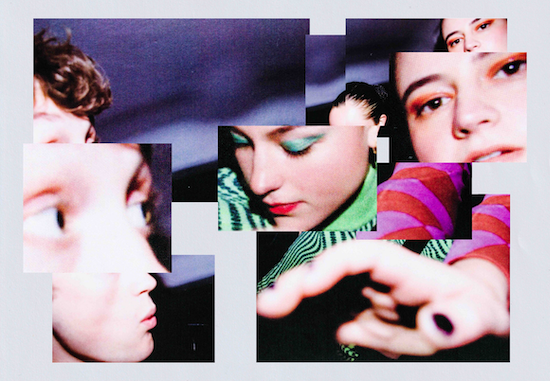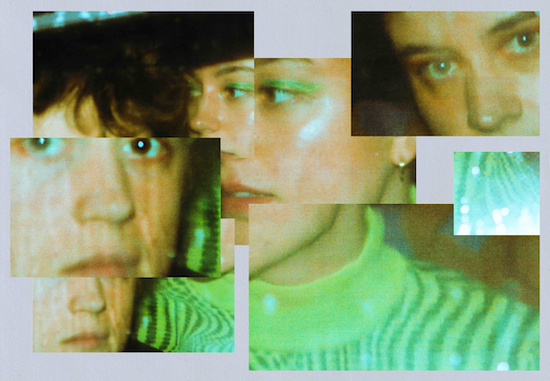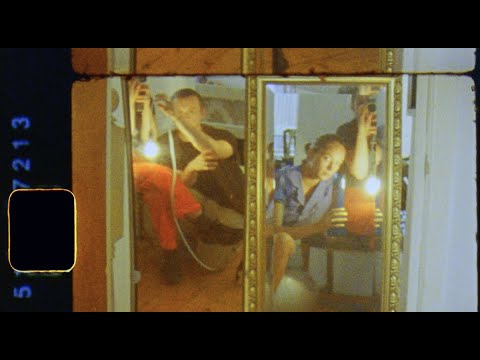Photos by Neelam Vela
The Goyt Valley is a blustery, tree-lined moorland around the river Goyt, located just outside Buxton on the border between Cheshire and Derbyshire. Textile mills, long emptied, give way to the wide-open valley which is reputed to be haunted by the ghost of a woman whose husband drowned in the river. She passes out the centuries wailing for her lover’s unlikely return. The Goyt Valley also lends its name to what The Orielles term The Goyt Method. The process would unlock and become central to the creation of Tableau, the band’s third album and first double record.
“We were at a studio in Goyt Mill,” remembers drummer Sidonie Hand-Halford, sat outside an East London pub. “We were doing some remixing, and we realised that having all of these stems, it was like having access to all of these paints. A huge colour palette. You could do that with anything, we realised, and the outcome could be millions of variations.” What, they wondered, if they were to apply that process not just to a remix but to their own work? In-between albums at the time, the band knew that this lightbulb moment would dictate where things would go next.
“We discovered how many avenues were open to us,” agrees vocalist Esmé Hand-Halford, “by taking an acoustic sound, and throwing it through a load of electronic plugins, and really effective randomisation methods, we could make it sound really different to the original source.” The album became governed by the band’s internal shorthand – to Goyt it.
The Orielles formed in the West Yorkshire market town of Halifax over a decade ago when they were in their teens, and gained a foothold as part of the indie and DIY scene around Manchester and Salford, where the band all live today. In 2017, they signed to Heavenly Recordings. Their second single for the label, the slippery nine-minute prog track ‘Sugar Tastes Like Salt’, would be early evidence of a band with far more exploratory impulses than they may have been given credit (the track was also subject to a terrific, dubbed out remix by Andrew Weatherall.) Where 2018’s Silver Dollar Moment was an assured debut of lo-fi indie pop, 2020’s superior Disco Volador would convincingly fuse the spectral pop of Stereolab and Broadcast with the tight avant-funk of A Certain Ratio (whose Jez Kerr was an important early mentor to the group.) When lockdown hit, the band even directed and scored their own art film, La Vita Olistica. None of this, though, would particularly anticipate the sounds heard across Tableau. Though seldom in thrall to influences or especially referential, the double album at points evokes Burial, Sonic Youth, FKA Twigs, Yo La Tengo, free jazz and the last two Radiohead records.
What happened? “In the past,” explains Esmé, “we’d resigned ourselves to the idea that it wasn’t possible to make something that sounds like it’s from the present or the future.” All in their early to mid twenties, for the first time the band found themselves all listening to far more contemporary music than sounds from the past. “Revisiting our processes means that what we were discussing was exactly the present and the future, we found our own view of what stuff should sound like now.”
The vibrant new music culture around Greater Manchester helped too. “All Night Flights in Stockport is such a well curated shop,” enthuses Sidonie, “also, things like going to White Hotel nights together, enjoying the music so much that the following day, you’re seeking out what they’re playing and chatting about it, all very nerdy.”
“It was how we were listening to music too,” says Henry Carlyle-Wade, the band’s guitarist. The oblique, downer sounds that have so far typified electronic music in the early 21st century became part of The Orielles’ language. “A lot of modern stuff is dark and introspective. It came from electronic DJs, people who do all of their work in the computer, we’re very interested in what they can do.”
The band knew that their new methodology could create something that, for the first time in their careers, would look the present moment firmly in the eye. How to get there? First, record as much as possible in adherence to The Goyt Method. Second, there would be no demoing of material (two album cycles had led the band to be suspicious of albums that ended up as “posh demos”). Third, the band would self-produce in collaboration with friend and relatively unknown North West producer Joel Anthony Patchett (who engineered on the first two Orielles records.) “Because we’ve got our communications and angle, he’s one of the only people that’s musically connecting with us,” explains Esmé. Though the record is Patchett’s first production credit, the band speak of him as an equal collaborator on the record and central to its scope and ambition.

“Imagine trying to achieve what we did with someone who we met for the first time on the first day in the studio?” says Henry, shaking his head, “it would be nearly impossible. We didn’t want someone who would think we were pissing around for hours. How can you explore the possibilities if someone thinks they know better? We don’t know, and that’s the best part of it.”
Esmé points to The Beatles’ Get Back as an example of good studio practices. “It wasn’t a reference point while we were writing, but they write it all on the spot together. That’s really what music should be. It isn’t making demos for a record label, who then throw a few grand at it. The time spent in the studio should be the time spent experimenting.”
“We decided not to overwrite anything either,” furthers Henry, “not really any structural things, and just see what would happen when we played these songs as they were being recorded. Because we had unfinished songs it forced us into a corner of being completely creative. We felt free. Maybe other people might have felt pressure but that wasn’t the case for us.”
Having convinced their record label, the band and Patchett devised two residential studio stays in Eastbourne and the Midlands town of Alcester. The decision to work in a residential stay was as much culinary as it was sonic. “Cooking together helps break down the barriers,” enthuses Esmé. “Showing people new ideas musically is easier if you’re also cooking them a breakfast or if they’re going to cook you a tea. On a rookie level, if you’ve got the same things in your gut, the outcome is going to be more in sync.” It also afforded the band the opportunity to work at their own schedule. “You get the ick sometimes if you work for too long,” explains Henry, “and we got the ick. From a sonic and spiritual perspective, too, we needed the high ceilings. It puts us in a better place to be able to explore that emotional palette.”
For the band, the high point of the sessions was Patchett bringing in the Northern Session Collective, the innovative string section led by Lancashire violinist Isabella Baker. In line with the album’s rigid commitment to chance, the band did not want to hear the scores that Patchett had written until the recording itself.
“We’d just planned to have strings on these four or five songs,” explains Sidonie, “but at the last minute we had an hour or so left. We had the song ‘Improvisation 001’, in which we all improvise, and it was a one take thing for us. We asked them to do the same, just improvise. We said we weren’t going to judge, just listen to it and react. And they did.”
Improvisation and chance would become central to Tableau, and The Orielles cultivated processes beyond simply jamming. They embraced automatic lyric writing, use of Brian Eno and Peter Schmidt’s Oblique Strategies cards, and Sidonie developing an interest in US jazz trumpeter Wadada Leo Smith’s concept of graphic scoring of music – the abstract, conceptual notation method that utilises the interplay of shapes and colour.
“I like the element of randomness, working within the bounds of what you’re given,” explains Henry, “we came to remix the album recently, and we had all these stems, all the songs, all these endless, endless possibilities. We put everything into online Wheel Of Fortune style spinners, so it was completely random, and the machine decided we’d take a drum track from here, a synth track from there.”
“It harkens back to early ideas of cybernetics in the 1960s, that computer technology could decide the elements,” ,” says Sidonie, “Look at the DALL-E AI art simulator. Just handing it to a robot to decide how we use it.”
For The Orielles, part of what has enabled them to develop their current work is what happens if you don’t become a hype band. “We discuss trends a lot, between the three of us, whether it’s fashion or film or music,” explains Henry, “British music moves so fast, these cycles and trends and trying to predict the future. It means you can see stuff for what it is, which is a trend no more than Crocs being back in right now. If you can identify substance, then you can reject everything that you just see through.” The three-piece would discuss their favourite acts – Sonic Youth, The Pastels, Yo La Tengo – and observe how those acts had found longevity.

Esmé introduced the group to the concept of the Lindy Effect, the idea that the longer a non-perishable item or idea has been around, the longer it’s likely to persist into the future. Introduced in a 1964 New Republican article by the writer Albert Goldman, the concept initially referred to Lindy’s Delicatessen on Broadway, where comedians would gather and talk shop, and the concept developed when discussing the impermanence of comedians who would oversaturate themselves early on in their career. Mathematicians like Nassim Taleb and Benoit Mandelbrot would take the idea from an anecdotal one to a mathematical formulation.
“There’s certain Lindy approaches to music,” Esmé argues, “it’s rejecting the idea of being a hype band. It might be really enjoyable for a year, but what about its lifespan?” It helped, too, that the band were at a formative age when they encountered the fevered egos of the hype artist in clubs and festival backstage areas across the UK. “You speak to those bands now, without naming any names,” says Sidonie, “and there’s something not even creative about them, they hate it now.”
For the future, the band are simply looking forward to taking Tableau out to two live shows – at Manchester’s Stoller Hall and Hackney’s EartH – where they will perform the record in full with the Northern Session Collective. When I speak to the band, they are in the thick of rehearsals for these shows. “You fall back in love with certain songs and out of love with others, the cycle does keep changing,” explains Esmé, “and then going forward next year, we’ve got certain songs that we’ve not played out as much and we’re definitely going to focus on, other ones will be put back for a bit. We’re constantly reinventing how our live sound is.”
“We’ve always loved the live sound being a completely different entity to the album anyway,” says Sidonie, “who is to say we can’t Goyt the whole thing for a live set?”
The Orielles’ Tableau is released on October 7 via Heavenly Recordings



